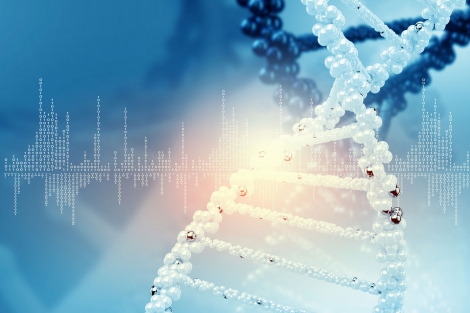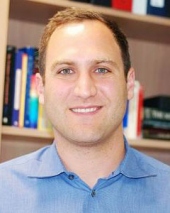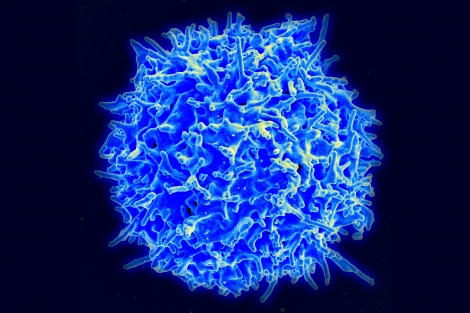Blunting CRISPR’s ‘Scissors’ Gives New Insight into Autoimmune Disorders
New Method Allows ‘20,000 Parallel Experiments’ in Search for Gene Activators
 Each one of our cells has the same 22,000 or so genes in its genome, but each uses different combinations of those same genes, turning them on and off as their role and situation demand. It is these patterns of expressed and repressed genes that determine what kind of cell – kidney, brain, skin, heart – each will become.
Each one of our cells has the same 22,000 or so genes in its genome, but each uses different combinations of those same genes, turning them on and off as their role and situation demand. It is these patterns of expressed and repressed genes that determine what kind of cell – kidney, brain, skin, heart – each will become.
To control these shifting patterns, our genomes contain regulatory sequences that turn genes on and off in response to specific chemical cues. Among these are “enhancers,” sequences that can sit tens of thousands of genetic letters away from a gene, yet still force it into overdrive when activated. Missteps in this delicate choreography can lead cells to take on the wrong role, causing debilitating diseases, but the regulatory regions involved are difficult to find and study since they only play a role in specific cells, often under very specific conditions.
Now a research team led by University of California scientists has used a modified version of the gene-editing technique CRISPR to find enhancers – not by editing them but by prompting them into action. As reported online Aug. 30, 2017, in Nature, a team from UC San Francisco and UC Berkeley used a tool called CRISPR activation (CRISPRa), developed at UCSF in 2013, to search for enhancers of a gene that affects development of the immune cells known as T cells. The sequences they found illuminate fundamental circuitry of autoimmune disorders such as inflammatory bowel disease (IBD) and Crohn’s disease.
The work was conducted in the laboratories of Alexander Marson, MD, PhD, assistant professor of microbiology and immunology at UCSF, and Jacob Corn, PhD, assistant adjunct professor of molecular and cell biology at Berkeley.
“Not only can we now find these regulatory regions, but we can do it so quickly and easily that it’s mind-blowing,” said Corn. “It would have taken years to find just one before, but now it takes a single person just a few months to find several.”
Corn is co-founder and scientific director of the Innovative Genomics Institute (IGI), a Berkeley-UCSF initiative of which Marson is an affiliate member. The IGI aims to advance CRISPR-based genome editing in medicine and agriculture to cure human disease, end hunger, and protect the environment.
CRISPRa Turns on Enhancers
The advent of CRISPR has allowed researchers to make rapid progress in understanding protein-coding genes. In the most common application of CRISPR, an enzyme called Cas9 snips DNA at particular sequences specified by the sequence of a “guide RNA.” Using the technology, scientists can excise or edit any gene, and observe how these changes affect cells or whole organisms.

But sequences that code directly for proteins make up only 2 percent of our genome. Enhancers and other regulatory DNA elements spread throughout the other 98 percent are more difficult to study, but are implicated in a large number of genetic disorders. Scientists can look for potential enhancer sequences based on how they interact with proteins that bind to DNA, but figuring out which enhancers work with which genes is much more challenging. Simply cutting out an enhancer with CRISPR-Cas9 doesn’t help, because it won’t have a noticeable effect if the enhancer is inactive in the particular cell type used in an experiment.
If you think of the genome as a model home with 22,000 lightbulbs (the genes) and hundreds of thousands of switches (the enhancers), the challenges have been finding all of the switches and figuring out which lightbulbs they control and when. Previously, CRISPR has been used to cut out wires looking for those that would cause a bulb to go dark, giving a good idea of what that section of the circuit was doing. However, cutting out a light switch when it’s off doesn’t tell you anything about what it controls. So, in order to find certain light switches, it has been common to try to mimic the complicated chemical cues that activate an enhancer.
But using this method, “you can quickly go insane trying to find an enhancer,” said Benjamin Gowen, a postdoctoral fellow in Corn’s lab at Berkeley and one of the study’s lead authors.
A better approach would be a universal “on” switch that could target any part of the genome and, if that part included an enhancer, could activate that enhancer. Fortunately, CRISPRa, recently developed by Jonathan Weissman, PhD, professor of cellular and molecular pharmacology at UCSF and co-director of the IGI, is just such a tool. CRISPRa uses a "blunted" version of the DNA-cutting Cas9 protein, strapped to a chain of activating proteins. Although CRISPRa also uses guide RNA to target precise locations in the genome, instead of cutting DNA, CRISPRa can activate any enhancers in the area.
While the first applications of CRISPRa involved using a single guide RNA to find promoters – sequences right next to genes that help turn them on – the UCSF/Berkeley team behind the new study realized that CRISPRa could help find enhancers too. By targeting the CRISPRa complex to thousands of different potential enhancer sites, they reasoned, they would be able to determine which had the ability to turn on a particular gene, even if that gene was far away from the enhancer on the chromosome.
“This is a fundamentally different way of looking at non-coding regulatory sequences,” said Dimitre Simeonov, a PhD student in Marson’s lab at UCSF and the study’s other lead author.
Performing 20,000 Experiments at Once
The gene the team chose to study produces a protein called IL2RA, which is critical to the function of immune cells called T cells. Depending on conditions in the body, T cells have the ability to either trigger inflammation or suppress it. The IL2RA gene produces a protein that tells T cells that it’s time to put on their anti-inflammatory hats. If the enhancers that should turn on the gene have errors, the cells fail to suppress inflammation, potentially leading to autoimmune disorders like Crohn’s disease.

To track down locations of the enhancers that control IL2RA, the UCSF and Berkeley team produced over 20,000 different guide RNAs and put them into T cells with a modified Cas9 protein.
“We essentially performed 20,000 experiments in parallel to find all the sequences that turn on this gene,” Marson said.
Sure enough, targeting some of the sequences with CRISPRa increased IL2RA production, yielding a short list of locations that might be important for regulating the fate of T cells.
“Whenever you get a chance to ask a question in a totally new way, you can suddenly discover things that you would have missed with older methods,” said Gowen. “We found these enhancers without having to make any assumption of what they looked like.”
Tying Mutant Enhancers to Inflammatory Disease
One of the likely enhancer sequences the team identified included the site of a common genetic variant that was already known to increase the risk of IBD, though how it did so was not understood. Marson and Corn’s teams wondered whether this genetic variation might alter the switch regulating the amount of IL2RA protein present in T cells. To test this, they modified mouse T cells so they contained the genetic variant associated with human disease, and found that these T cells indeed produced less IL2RA.
“This starts to unlock the fundamental circuitry of immune cell regulation, which will dramatically increase our understanding of disease,” said Marson.
The team next hopes to expand the method, perhaps by finding ways to search for enhancers of many different genes at once, making the search for regulators of immune disorders that much faster. And they expect the method to be a widely applicable tool for untying genetic interactions in all kinds of cells.
“We believe this is going to be a very generally useful method,” said Corn. “It would be easy for someone interested in neurons or any other cell type to pick it up and look for the enhancers involved in programming those cells’ behavior.”
Other authors on the study include Theodore L. Roth, Youjin Lee, John D. Gagnon, Alice Y. Chan, Dmytro S. Lituiev, Michelle L. Nguyen, Rachel E. Gate, Eric Boyer, Frederic Van Gool, Meena Subramaniam, Zhongmei Li, Jonathan M. Woo, Victoria R. Tobin, Kathrin Schumann, K. Mark Ansel, Chun Ye, William J. Greenleaf, Mark S. Anderson, and Jeffrey A. Bluestone of UCSF; Mandy Boontanrart, Nicolas L. Bray, Therese Mitros, Graham J. Ray, Gemma L. Curie, Nicki Naddaf, Julia S. Chu, and Hong Ma of Berkeley; Maxwell R. Mumbach, Howard Y. Chang, and Ansuman T. Satpathy of Stanford University; Hailiang Huang, Ruize Liu and Mark J. Daly of Harvard University; and Kyle K. Farh of Illumina Inc.
This research was supported by the National Institutes of Health (grants DP3DK111914-01, R01HG0081410-01, R01HL109102, P50-HG007735, S10RR029668, S10RR027303, and P30 DK063720), the Scleroderma Research Foundation, the UCSF Sandler Fellowship, a gift from Jake Aronov, a National Multiple Sclerosis Society grant (CA 1074-A-21), and the Marcus Program in Precision Medicine Innovation. Marson and Schumann have filed a patent on the use of Cas9 ribonuclear proteins to edit the genome of human primary hematopoietic cells. Chang and Greenleaf are co-founders of Epinomics. Marson serves as an advisor to Juno Therapeutics and PACT Therapeutics, and the Marson lab has received sponsored research support from Juno Therapeutics and Epinomics.
UC San Francisco (UCSF) is a leading university dedicated to promoting health worldwide through advanced biomedical research, graduate-level education in the life sciences and health professions, and excellence in patient care. It includes top-ranked graduate schools of dentistry, medicine, nursing and pharmacy; a graduate division with nationally renowned programs in basic, biomedical, translational and population sciences; and a preeminent biomedical research enterprise. It also includes UCSF Health, which comprises three top-ranked hospitals, UCSF Medical Center and UCSF Benioff Children’s Hospitals in San Francisco and Oakland, and other partner and affiliated hospitals and healthcare providers throughout the Bay Area.